From Arms to AI: Features of Popular Industrial Robot Types
Introduction
Industrial robots have become a cornerstone in modern manufacturing, significantly improving efficiency, precision, and speed in production processes. Among the various types, Cartesian, SCARA, and six-axis robots are frequently used due to their unique capabilities that make them suitable for specific tasks. Cartesian robots are ideal for linear, pick-and-place operations, SCARA robots excel in high-speed horizontal assembly tasks, and six-axis robots are known for their flexibility and full range of motion, making them ideal for complex operations such as welding and assembly.
These robots are transforming industries like automotive, electronics, pharmaceuticals, and packaging by automating tasks that were traditionally done by humans. The use of advanced controls and user-friendly programming systems has made these robots even more accessible to plant operators, with some systems even offering online tools for quick configuration
Cartesian Robots ( linear Robots)
These robots operate on three linear axes: X, Y, and Z. A Cartesian robot moves methodically along its three linear axes, its motions clean and predictable
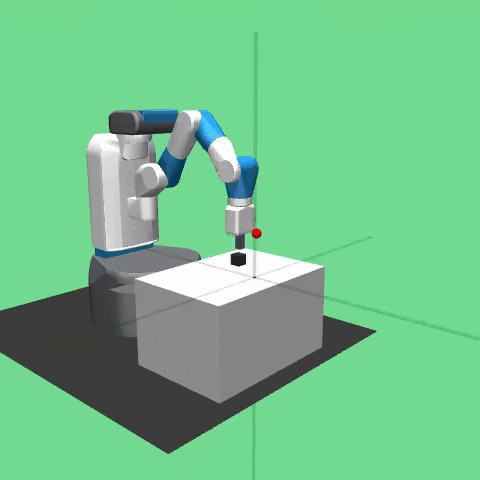
Ideal for pick-and-place tasks, perhaps transferring components from one location to another with effortless precision.
Its cube-shaped workspace, defined by the straight lines it moves along, might seem simple, but it’s perfectly suited to repetitive tasks where accuracy is paramount.
Plant operators often favour this type of robot for its ease of use. They know that with minimal programming, the Cartesian robot can perform its duties reliably, day in and day out.
Strengths and weaknesses
In industrial settings, simple-to-program robots that can be operated offline offer great ease of use and flexibility. Their precision in straight-line motion makes them ideal for repetitive tasks like pick-and-place, packaging, and material handling. These robots are cost-effective due to their straightforward design, offering reliable automation without high expenses. Additionally, their cube-shaped workspace is particularly well-suited for structured and repetitive tasks. While they may lack flexibility for more complex or rotational movements, their strengths in accuracy, efficiency, and affordability make them valuable in specific applications.
Despite their many advantages, these robots have limited flexibility due to their reliance on linear movements. Their design restricts them to straight-line tasks, and unsuitable for complex or rotational motion. As a result, these robots may not be suitable for industries or tasks that require a high degree of versatility or intricate, multi-directional actions, limiting their applicability in more dynamic or specialised environments.
Applications: Automating material handling in the electronics industry such as Foxconn, the world’s largest electronics manufacturer and the primary assembler for Apple’s iPhones. They are also used at Amazon’s fulfilment centres, where Cartesian robots are deployed to automate packaging and labelling tasks.
Compared to SCARA or articulated arm robots, Cartesian robots are:
- Simpler to control and program (due to linear motion along three perpendicular axes),
- More cost-effective for certain tasks that don’t require complex movement or flexibility,
- Capable of high precision and repeatability, especially in large-scale operations.
Scara Robots (Selective Compliance Articulated Robot Arm)
Scara robots operate in a cylindrical workspace with rotational movement around the Z-axis and linear movement in X and Y axes
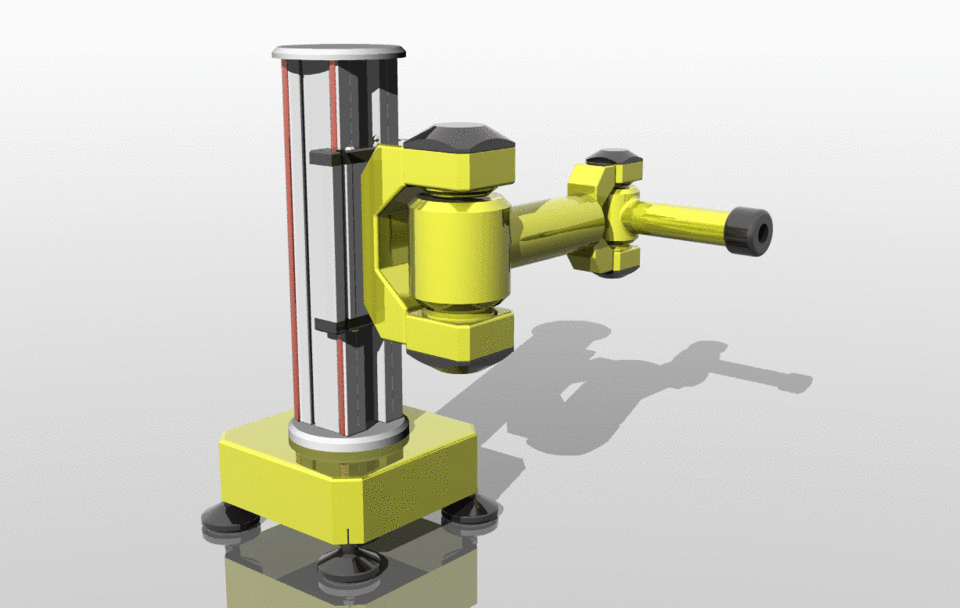
Unlike the Cartesian robot, the SCARA is designed for speed, working on tasks that require quick, horizontal movements, like assembling electronics. Its compact design allows it to fit into tight spaces, performing tasks that demand both speed and accuracy. Its specialised movements are perfect for placing tiny components on circuit boards, or for packaging small parts at lightning speed.
Strengths and weaknesses.
Their compact design not only enhances their flexibility but also allows them to operate effectively in constrained spaces, making them ideal for environments with limited room. This combination of precision, speed, and space efficiency makes these robots invaluable in sectors that demand both productivity and careful handling.
These robots are limited by their restricted vertical reach and offer less flexibility compared to six-axis robots in handling complex 3D movements. As a result, they are less suitable for tasks requiring extensive height variation or intricate, multi-directional actions.
Applications; High-Speed Assembly in Electronics and Pharmaceuticals Samsung Electronics, where precision and speed are critical for assembling products such as smartphones and TVs. Pfizer uses SCARA robots in their production lines to manage the delicate process of filling vials with vaccines or other drugs.
Six-Axis Robots (Articulated Robots)
The six-axis robot, standing tall and dominating its workspace with a grace that belies its size. With its ability to move along six degrees of freedom, it mimics the movements of a human arm.
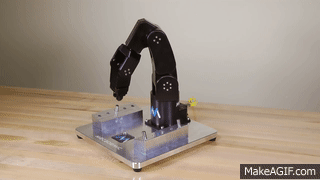
In an automotive plant, this robot might be responsible for welding car frames together, its intricate movements programmed to ensure perfect precision with each weld. The six-axis robot is the epitome of flexibility, able to adapt to complex tasks that require a full range of motion, making it an essential tool in industries where versatility is key.
Strengths and weaknesses.
Robots with extreme flexibility are highly capable of performing complex, multi-dimensional tasks. Their ability to reach around objects or into tight spaces makes them ideal for applications where other robots may struggle. While these highly flexible robots offer superior capabilities, they tend to be more expensive and complex to program and operate compared to simpler robots. Their complex joints and motors also require more maintenance, leading to higher operational costs and upkeep. Despite their advanced functionality, these factors can make them less practical for simpler tasks where such flexibility is unnecessary.
Application: Welding and Assembly in Automotive Manufacturing. The automotive industry has long been a leader in adopting six-axis robots, the most notable examples are at Tesla’s Gigafactory and BMW’s production plant in Germany.
Cylindrical Robots
The cylindrical robot is mounted on a fixed base, like a pillar in the centre of a circular workspace. Its movements are defined by three key abilities: it rotates around its vertical axis, extends its arm out horizontally, and raises or lowers itself along a straight vertical track. These movements are straightforward, but they combine to give the robot a surprising range of versatility within its cylindrical work envelope.
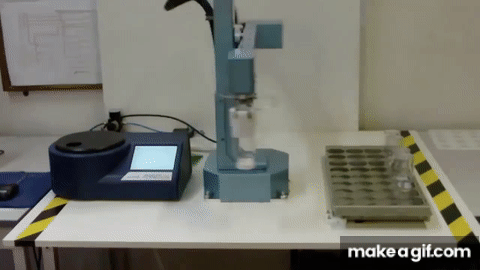
Strengths and weaknesses
These robots are well-suited for assembly tasks requiring rotational movements, providing precise handling in such applications. With a simple design, they are cost-effective and ideal for tasks where rotational motion is crucial, without needing more complex and expensive robotic solutions.or assembly tasks that require rotational movements.
These robots are less flexible than articulated robots, which limits their range of motion and adaptability. Additionally, their cylindrical workspace restricts them to specific tasks, reducing their suitability for a broader range of applications where more versatile movements are needed.
Application: metal fabrication shops, like Mazak Corporation, these robots feed raw materials into machines, supervise the machining process, and remove finished parts.
Delta Robots (Parallel Robots)
A Delta robot is a type of parallel robot known for its high speed and precision in pick-and-place operations. It consists of three lightweight arms connected to universal joints at the base. The arms converge at a common end effector, which is capable of moving in three dimensions (X, Y, and Z). The unique parallel structure allows the Delta robot to perform rapid movements with high accuracy, especially in applications that require fast handling of small objects.
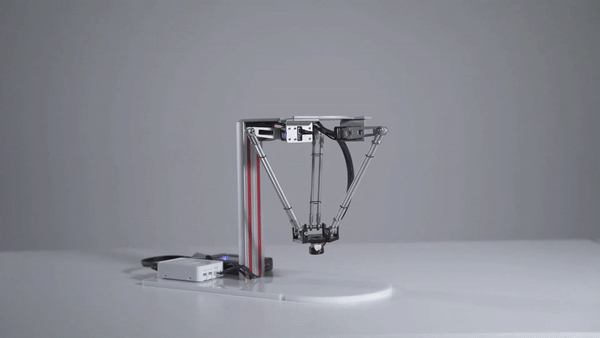
Delta robots are commonly used in industries like food processing, pharmaceuticals, and electronics, where quick and precise handling is essential. Their compact design, combined with the ability to perform repetitive tasks at high speeds, makes them ideal for high-throughput environments.
Strengths and weaknesses.
These robots are extremely fast and accurate, making them particularly effective in picking and sorting applications where speed and precision are essential. They are also well-suited for high-speed, light-load tasks, offering efficiency and reliability in environments that require quick handling of lightweight items, such as packaging and material sorting.
These robots are limited to lightweight tasks, as they lack the capability to handle heavy loads or perform more complex motions. Their design restricts them to simpler applications, making them unsuitable for tasks that require significant strength or intricate movements.
Applications: High-Speed Picking and Sorting in Food and Beverage companies like Nestlé and PepsiCo use delta robots to perform high-speed sorting and packaging tasks.
Polar Robots (Spherical Robots)
A polar robot is an industrial robot with a rotating base and a combination of rotational and linear joints that allow it to move in a spherical coordinate system. Its structure typically includes:
- A rotary base joint for horizontal rotation (θ-axis),
- A pivoting arm for vertical movement (φ-axis),
- A telescoping arm that extends and retracts radially (r-axis).
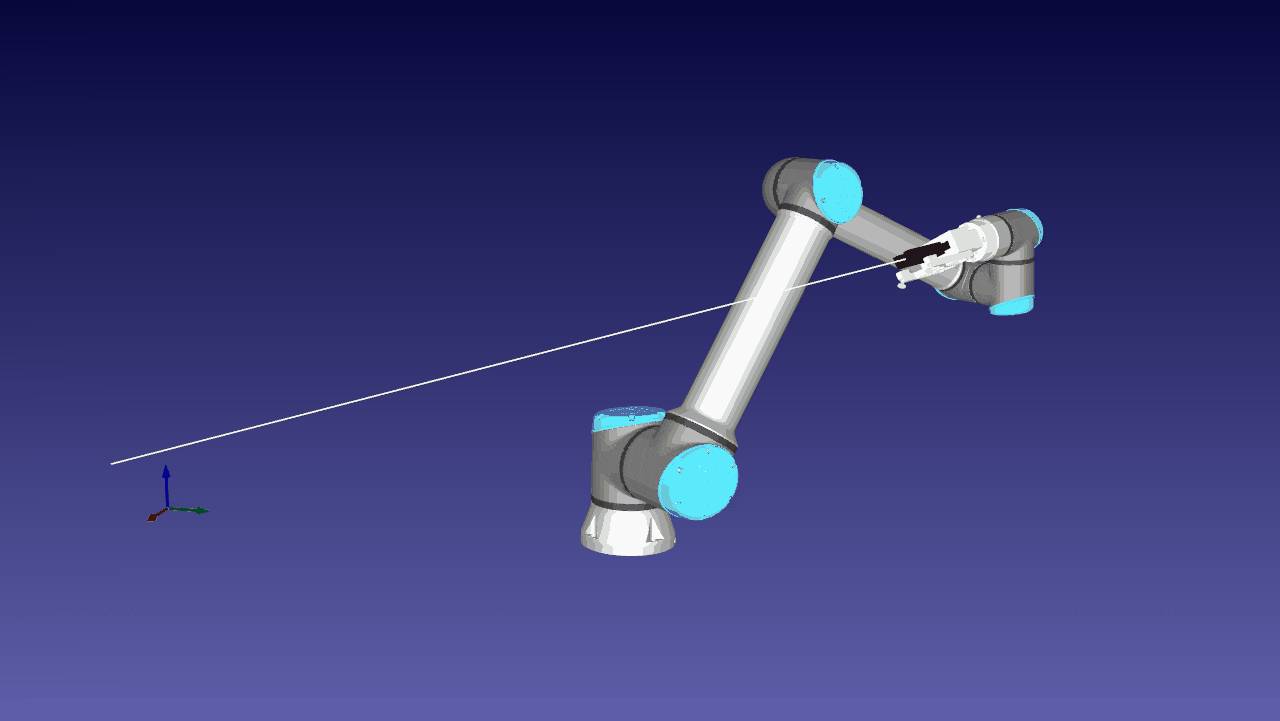
Key Features include a spherical work envelope which provides flexibility in reaching various positions.Rotational and linear movement which combines rotation and telescoping for broad reach.
Polar robots are often used in environments where tasks involve reaching around obstacles or working in large spaces, but they are less common today compared to other robot types like articulated or Cartesian robots.
Strengths and weaknesses.
These robots offer a wide range of motion with both rotation and translation movements, allowing them to handle complex tasks. They are particularly useful for reaching around objects and accessing difficult-to-reach areas, making them ideal for applications that require flexibility and precision in navigating tight or complex spaces.
They are not as precise as other types like Cartesian or delta robots, which limits their effectiveness in tasks that require high precision. Additionally, they have limited use in high-precision or high-speed applications, making them less suitable for industries or tasks where accuracy and speed are critical factors.
Applications: Injection Moulding in Plastics Manufacturing such as Nissei Plastic Industrial Co.Ltd., where they assist with injection moulding, a process in which plastic is heated and injected into moulds to form parts for industries like automotive, electronics, and consumer goods.
This rise of robots is ushering in a new era of efficiency. Factories are becoming more productive, turning out products at a rate that would have been unimaginable just a few decades ago. Robots, once confined to simple tasks, are now integral parts of the manufacturing ecosystem, handling everything from basic assembly to complex, precision-driven operation
The Bigger Picture: Collaborative Robots (Cobots)
A growing trend across industries is the use of collaborative robots (cobots), which are designed to work alongside human operators. Companies like Universal Robots have developed cobots that can be programmed quickly to assist with tasks like assembly, material handling, and even quality inspection. Cobots have been deployed in small and medium-sized enterprises where flexibility and human-robot collaboration are essential. For example, BMW’s plant in South Carolina uses Cobots to assist human workers in delicate assembly tasks, improving both productivity and ergonomics by relieving workers of physically strenuous or repetitive jobs.
From automotive giants like Tesla and BMW to electronics manufacturers like Foxconn and Samsung, industrial robots are reshaping production lines across the globe. Each type of robot, Cartesian, SCARA, six-axis, delta, cylindrical, and polar, has its niche, allowing industries to automate specific tasks with remarkable precision, speed, and reliability. As automation continues to advance, the boundaries of what robots can achieve will expand even further, driving efficiency and innovation across all sectors.
Interested in our Electrical Engineering Courses?
At iLearn Engineering®, we offer a diverse range of online accredited electrical engineering courses and qualifications to cater to different academic and career goals. Our courses are available in varying credit values and levels, ranging from 40 credit Engineering Diplomas to a 360 credit International Graduate Diploma.
Short Courses (40 Credits)
A selection of our more popular 40 credit electrical diplomas…
Diploma in Electrical and Electronic Engineering
Diploma in Electrical Technology
Diploma in Renewable Energy (Electrical)
First Year of Undergraduate (Level 4 – 120 Credits)
Higher International Certificate in Electrical and Electronic Engineering
First Two Years of Undergraduate (Level 5 – 240 Credits)
Higher International Diploma in Electrical and Electronic Engineering.
Degree equivalent Graduate Diploma (Level 6 – 360 Credits)
International Graduate Diploma in Electrical and Electronic Engineering
All Electrical and Electronic Courses
You can read more about our selection of accredited online Electrical and Electronic Engineering courses here.
Complete Engineering Course Catalogue (all courses)
Alternatively, you can view all our online engineering courses here.
Recent Posts
Understanding and Calculating Generator Efficiency and Output Parameters
Understanding and Calculating Generator Efficiency and Output Parameters Introduction The performance of a generator is often judged by how efficiently it converts mechanical energy into electrical energy. Understanding and calculating this efficiency, along with other key output parameters such as voltage, current, power factor, and load, is essential for evaluating performance and ensuring reliable operation. […]
Essential Cooling and Protection Devices: How They Work and Why They Matter
Essential Cooling and Protection Devices: How They Work and Why They Matter Introduction Generators produce a significant amount of heat and electrical stress during operation, which can affect performance and lifespan if not properly managed. That’s where cooling and protection devices come in. These essential systems, including fans, radiators, circuit breakers, and relays, work together […]
Justifying the Choice of Generators Based on Requirements and Characteristics
Justifying the Choice of Generators Based on Requirements and Characteristics Introduction Selecting the right generator isn’t just about power output, it’s about finding a machine that meets specific operational needs, efficiency goals, and environmental conditions. Different applications demand different generator types, capacities, and features. In this article, we’ll explore how to justify the choice of […]

